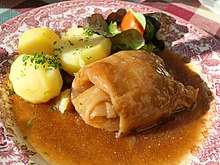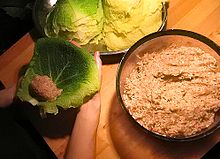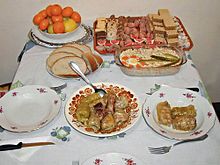Cabbage roll
Stuffed cabbage , cabbage rolls , herb sausage or stuffed cabbage , as well as in Austria and Stuffed cabbage is in the German language the term for different variants stuffed cabbage leaves , which are cooked, steamed or braised.
Preparation variants
The variants widespread in Germany are made from savoy cabbage , white cabbage and, more rarely, red cabbage leaves, which are first blanched and then several leaves are placed on top of each other. These are wrapped around a seasoned meat mixture made from minced meat , bacon , onions , salt , pepper and spices, tied with kitchen thread or pinned together with roulade needles or wooden skewers (also toothpicks ). They are braised in a little meat stock at medium temperature. According to some recipes, the filling may contain rice or the sauce tomato paste and bacon. The usual side dishes are boiled potatoes or mashed potatoes .
In the Balkans , cabbage rolls are made from soured white cabbage leaves , kale or grape leaves. Like in Turkey, where they are often cooked in lemon stock, they are called sarma ( Turkish: roulade).
In Romania , the sarmale (plural of sarma ) are usually seasoned with dill . In the northeast of the country, they are only the size of a walnut and are served as a side dish with the polenta- like corn dish Mămăligă .
In Hungary as töltött káposzta , in Poland as Gołąbki and in Russia as Golubzy . In Eastern European recipes, the filling made of seasoned grain , onions and minced meat is usually fried before filling and only then rolled into cabbage leaves. The cabbage rolls are steamed in tomato sauce or served in a creamy sauce, which can also contain mushrooms.
The northern Greek "sarmades" are stuffed with minced, not ground pork and served with avgolemono .
A comparable preparation with different ingredients can be found in the Graubünden specialty Capuns .
Historical roots
The basic preparation of cooking (vegetable) leaves stuffed goes back to the kitchen in the Byzantine Empire . At that time, leaves from various plants were used, including the dolma , which is still widespread in the eastern Mediterranean under various names , a variant in which the filling is wrapped with vine leaves. The distribution area around the eastern Mediterranean, in which meat or vegetarian-filled dolma variations have survived to this day, corresponds to the expansion of the Byzantine Empire at that time. In most of these countries there are also cabbage rolls, although the respective national recipes do not differ significantly, regardless of whether the specifically seasoned fillings are coated with vine leaves, cabbage or other leaves such as chard.
In the rest of Europe, cabbage rolls can be traced back to the proliferation of cabbage as the main ingredient. This was especially popular in the cooler regions of Central and Eastern Europe as a vitamin donor in winter. Even today, cabbage dishes, including explicitly cabbage rolls, have a high priority in the national kitchens not only in German-speaking countries, but also in Eastern Europe , such as Russia , Poland , Ukraine , Hungary and Romania, or in the Balkans . In Serbia and Montenegro in particular , sarma is a popular course in the festive kitchen and is traditionally prepared at Christmas , Easter , the Slava or at weddings and christenings .
The cabbage rolls made with white cabbage have a special history in Sweden, where they are called "kåldolmar". The name suggests that the custom comes directly from the contacts with the Ottoman Empire, which were recorded during the lengthy stay of the Swedish army in Bender in today's Moldova (under the administration of Transnistria ) 1709–1713.
literature
- Reay Tannahill: Food in History . New and revised edition. Three rivers press, New York NY 1989, ISBN 0-517-88404-6 .
- Michael Hiltscher, Delia Dumitriu (ed.): At a table. Kitchen recipes from Romania and Germany. Editura Anima, Bucureşti 2004, ISBN 973-7729-00-5 .




